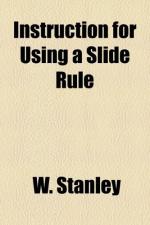|
This section contains 353 words (approx. 2 pages at 300 words per page) |
With the publication of logarithmic tables by John Napier (1550-1617) in 1614, astronomers and mathematicians were freed from much of the drudgery long associated with their professions. Some scholars realized that logarithms could be used in mechanical devices to take automatic calculation one step further. In 1620 Edmund Gunter (1581-1626), a professor at Gresham College, London, created a forerunner of the slide rule, which he described as his "logarithmic line of numbers."
Around that same time, English mathematician William Oughtred (1574-1660), began developing his own device employing Napier's logarithms. Although he was an ordained minister, Oughtred was most interested in mathematics and he spent every spare minute studying and planning his slide rule. In 1621 Oughtred introduced the device he had been perfecting--the first linear (or straight) slide rule. His device consisted of two sliding rulers marked with graduated scales representing logarithms, allowing calculations to be performed mechanically by sliding one ruler against the other. The invention caused quite a quarrel between Oughtred and his former pupil, Richard Delamain, because in 1630 Delamain described plans for his own design, a circular slide rule. Delays in publishing caused accounts of Delamain's device to appear in print before write-ups of Oughtred's slide rule appeared. While Oughtred accused Delamain of stealing his ideas, it has been generally concluded that the devices were both developed independently. In addition to his slide rule, Oughtred was also responsible for the introduction of the multiplication sign "x" and the trigonometric abbreviations still commonly used today--sin, cos and tan, for sine, cosine, and tangent.
Few innovations were made to slide rule design until 1902 when Norwegian Carl George Lange Barth copyrighted a design for a circular slide rule. An advanced model, it was intended to speed up mathematical calculations and offered several advantages, perhaps the most important of which was it did not "run off the scale," as the more traditional straight line device was known to do.
While early slide rules were commonly used by tax collectors, masons and carpenters, slide rules today are most often used in engineering. Simple, yet versatile instruments, they perform calculations quickly and with reasonable accuracy.
|
This section contains 353 words (approx. 2 pages at 300 words per page) |


